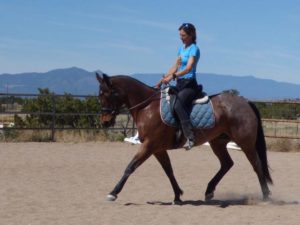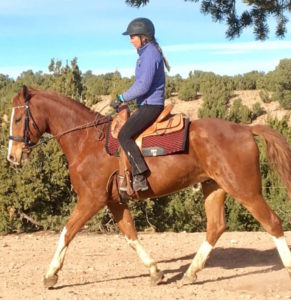
Katrin Silva rides with correct contact
Editor’s Note: Best Horse Practices Summit presenter Katrin Silva grew up riding dressage in Germany before moving to the United States at age 19 to learn to ride Western. She’s been riding both disciplines for the last 20 years and is a regular guest columnist for Cayuse Communications. The author of Dressage for All of Us: How to Help Any Horse Become a Happier, More Responsive Riding Partner lives in New Mexico where she works with dressage and Western clients. Visit her blog here.
This is a two-part column. Read Part II.
Silva writes:
The road to a well-trained horse – a dressage horse, a western horse, or any other horse – is not a single, clearly-marked path. It’s a maze, paved with good intentions and confusion. Signs contradict each other. Turns look promising, but lead to dead ends or long detours. There’s so much information from so many sources that it can be hard to decide which way to go. But if you listen, your horse will tell you whether you are on the right track. Here are 10 ways to tell whether your training is going in a good direction.
- Your horse becomes more beautiful.
This doesn’t happen overnight, of course, but when a horse carries his rider on a relaxed, swinging back, his topline develops. His neck muscles fill out right in front of the withers, not right behind his ears. His muscles ripple under his skin, which helps his coat shine. Even if his conformation is less than ideal, correct training will make him look more handsome over time.
- Your horse is willing to stretch forward and down in all three gaits.
 This is the best way to find out whether your horse steps with trust and confidence into the soft contact your hands offer. If your horse allows you to guide the energy from his hind legs into a soft connection over his back to his front end, he will lower his neck, stretch his entire spine, and lift his back whenever you lighten your seat and gradually lengthen your reins.
This is the best way to find out whether your horse steps with trust and confidence into the soft contact your hands offer. If your horse allows you to guide the energy from his hind legs into a soft connection over his back to his front end, he will lower his neck, stretch his entire spine, and lift his back whenever you lighten your seat and gradually lengthen your reins.
You should be able to do this at the walk, trot, or canter. If your contact is not correct – i.e. if the conversation between your hands and your horse’s mouth is neither pleasant nor meaningful, he will not stretch forward and down. Instead, he will rush forward, curl behind the bit, yank the bit out of your hands, or drop his neck without engaging his back.
If your horse stretches over his back into soft contact, you should be able to let the horse chew the reins out of your hands anytime at the walk, trot, and canter. If you lighten your seat and lengthen the reins, he should lower his neck, lift his back, and stretch his entire spine. If he instead curls behind the bit, hurries off, yanks the reins out of your hands, or drops his neck without keeping his back engaged, you know there is work to do.
- You can ride your horse on contact, but you don’t have to.
Good dressage riders soften often. Without changing anything else, they give one or both reins for a few strides, to check whether or not their horses relies on the reins for balance. A well-trained horse will not lose his steady tempo or rhythm. A well-trained dressage horse is also capable of going on a loose rein, e.g., on a relaxed trail ride. On the other side of the spectrum, a well-trained western or endurance horse who gets ridden without contact much of the time should be able to go on soft, elastic contact part of the time. Without some understanding of contact, it’s not possible to ride a horse correctly back to front, to turn him into a happy athlete with a well-developed topline and a strong, supple back.
- Transitions become smoother and more effortless.

Katrin Silva
A green horse will feel wobbly and unbalanced in transitions. That’s natural. As time goes by, as your horse learns to understand your way of talking to him, as he gets stronger, your horse will not have to run into the canter or hollow his back when he comes back from a trot to the walk. Effortless transitions are a sign of correct training. A horse can look like he is “on the bit” while trotting around the arena, but any lack of throughness will show in his transitions. If your horse is not strong enough or supple enough, or if he does not fully understand the language of your seat and hands, he will show it in his transitions”
- Your horse’s fitness increases.
After a few months of consistent training, he has enough endurance to canter around the arena at a brisk pace for a few minutes without his flanks heaving. He is strong enough to trot up a long hill. He can work for an hour, then still go on a trail ride. Endurance riders are well aware of this training component, while many dressage riders or recreational riders neglect it. Horses are athletes. An hour or more of steady work should not feel like an all-out effort.
This is a two-part column. Read Part II.
Love this list, Katrin. Working with my “western” horse all last summer and fall with a dressage trainer helped him take contact without fussing. He developed a beautiful topline and that muscle right in front of his withers popped out. He was definitely more fit and a more comfortable ride.
Thank you, Julie! I’m so happy to hear this. Stay tuned for the second half of the list 🙂
Really great explanation of the things to observe, watch for and feel. Love this. Thanks!
Nice breakdown. Transitions, transitions, transitions. Now after a few months off due to weather and surgery need to turn those ripples of fat into ripples of muscle. Minus about 200 pounds. LOL. Back to basics.